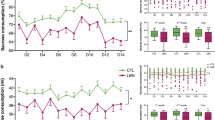Abstract
This article explores the development of a rat model of mother-infant relationships from its origins in the psychosomatic investigations of the mid-1960s to its elaboration into a theoretical system in neurobiology. I reconstruct the research trajectory of a group of neurobiologists in the United States, with a focus on the experimental practices they adopted while building this animal model. Providing a microhistory of this decade-long undertaking, I show that what drove the development of the model in practice was a serendipitous finding about infants’ response to maternal separation. Detected inadvertently, the pup’s separation response acquired an epistemic significance of its own and reoriented the experimental system towards unanticipated paths. To explain this intriguing phenomenon, the neurobiologists kept on refining their material manipulations and stabilizing their experimental outcomes. They thus established a series of causal relationships that connected dysregulations of the infant’s physiological systems to disruptions in maternal care. As important as this interactive stabilization of technique and objects in the laboratory was how the researchers theorized the network of relationships derived from this technically constituted objectivity. Highlighting the practice-driven aspects of model-building, I demonstrate that what facilitated this theoretical process was an integrated design of complementary experiments. The outcome of each separate experiment of the research program came to bear upon the outcomes of other experiments, informing the development of future manipulations. It was this strategically driven integration process that allowed the experimenters to build expanding networks of causal relationships and consolidate them into a neurobiological theory.
Similar content being viewed by others
References
Bickle, J., & Kostko, A. (2018). Connection experiments in neurobiology. Synthese, 195, 5271–5295.
Cameron, N. M., Champagne, F. A., Carine, P., Fish, E. W., Ozaki-Kuroda, K., & Meaney, M. J. (2005). The programming of individual differences in defensive responses and reproductive strategies in the rat through variations in maternal care. Neuroscience and Biobehavioral Reviews, 29, 843–865.
Collins, H. M. (1985). Changing order: Replication and induction in scientific practice. Sage Publications Inc.
Galison, P. (1987). How experiments end. Chicago, Illinois: University of Chicago Press.
Hacking, I. (1983). Representing and intervening: Introductory topics in the philosophy of natural science. Cambridge University Press.
Hofer, M. A. (1972). Physiological and behavioral processes in early maternal deprivation. Physiology emotions and psychosomatic illness a CIBA foundation symposium. Elsevier.
Hofer, M. A. (1970). Physiological responses of infant rats to separation from their mothers. Science, 168, 871–873.
Hofer, M. A. (1973a). The role of nutrition in the physiological and behavioral effects of early maternal separation on infant rats. Psychosomatic Medicine, 35(4), 350–359.
Hofer, M. A. (1973b). Maternal separation affects infant rats’ behavior. Behavioral Biology, 9, 629–633.
Hofer, M. A. (1973c). The effects of brief maternal separations on behavior and heart rate of two-week-old rat pups. Physiology and Behavior, 10, 423–427.
Hofer, M. A. (1975a). Studies on how early maternal separation produces behavioral change in young rats. Psychosomatic Medicine, 37(3), 245–264.
Hofer, M. A. (1975b). Infant separation responses and the maternal role. Biological Psychiatry, 10, 149–153.
Hofer, M. A. (1976). The organization of sleep and wakefulness after maternal separation in young rats. Developmental Psychobiology, 9(2), 189–205.
Hofer, M. A. (1984). Relationships as regulators: A psychobiologic perspective on bereavement. Psychosomatic Medicine, 46(3), 183–197.
Hofer, M. A., & Reiser, M. F. (1969). The development of cardiac rate regulation in preweanling rats. Psychosomatic Medicine, 31(5), 372–388.
Hofer, M. A., & Sullivan, R. (2001). Toward a neurobiology of attachment. In C. Nelson & M. Luciana (Eds.), The handbook of developmental neuroscience (pp. 599–616). MIT Press.
Hofer, M. A., & Weiner, H. (1971). Development and mechanisms of cardiorespiratory responses to maternal deprivation in rat pups. Psychosomatic Medicine, 33(4), 353–362.
Hofer, M. A., & Weiner, H. (1975). Physiological mechanisms for cardiac control by nutritional intake after early maternal separation in the young rat. Psychosomatic Medicine, 37(1), 8–24.
Keller, E. F. (2000). Models of and models for: Theory and practice in contemporary biology. Philosophy of Science, 67(3), S72–S86.
Knorr-Cetina, K. (1981). The manufacture of knowledge: An essay on the constructivist and contextual nature of science. Oxford: Pergamon Press.
Latour, B., & Woolgar, S. (1979). Laboratory life: The construction of scientific facts. Princeton University Press.
Lynch, M. E. (1985). Art and artifact in laboratory science. Routledge and Kegan Paul.
Peterson, D. (2015). All that is solid: Bench-Building at the Frontiers of two experimental sciences. American Sociological Review, 80(6), 1201–1225.
Rheinberger, H.-J. (1997). Toward a history of epistemic things: Synthesizing proteins in the test tube. Stanford University Press.
Silva, A. J., Landreth, A., & Bickle, J. (2014). Engineering the next revolution in neuroscience: The new science of experiment planning. Oxford University Press.
Singh, P. J., Tucker, A. M., & Hofer, M. A. (1976). Effects of nasal ZnSO4, irrigation and olfactory bulbectomy on rat pups. Physiology and Behavior, 17, 373–382.
Stone, E., Bonnet, K., & Hofer, M. A. (1976). Survival and development of maternally deprived rat pups: Role of body temperature. Psychosomatic Medicine, 38, 242–249.
Weaver, I. C. G., Cervoni, N., Champagne, F. A., D’Alessio, A. C., Sharma, S., Seckl, J. R., Dymov, S., Szyf, M., & Meaney, M. J. (2004). Epigenetic programming by maternal behavior. Nature Neuroscience, 7(8), 847–854.
Author information
Authors and Affiliations
Corresponding author
Additional information
Publisher's Note
Springer Nature remains neutral with regard to jurisdictional claims in published maps and institutional affiliations.
Rights and permissions
About this article
Cite this article
Polat, B. Modeling mothering: the development of an experimental system in neurobiology. HPLS 43, 94 (2021). https://doi.org/10.1007/s40656-021-00448-w
Received:
Accepted:
Published:
DOI: https://doi.org/10.1007/s40656-021-00448-w




